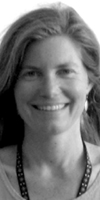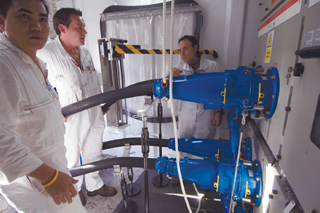
Surveys
DJC.COM
June 28, 2007
The Emerald City’s tourist industry turns green
Resource Venture

Bell
|
If you’ve spent any time walking the waterfront and downtown streets on a sunny day, you probably noticed the ever-increasing crowds pointing their cameras and toting city maps. Tourism is booming in the Emerald City.
According to Seattle’s Convention and Visitors Bureau, 2006 hotel occupancy was at an all-time high, the Port of Seattle played host to a record number of cruise ships, and airport passenger volumes topped a record with more than 30 million people. All signs point to more of the same for 2007.
With all the visitor traffic, Seattle is conscious of the burden tourism places on natural resources — from air and water quality to waste management, energy use and greenhouse gas emissions. Most resource conservation efforts go unnoticed to the average visitor or resident, but nonetheless, many of the businesses that benefit from Seattle’s tourist industry are greening their practices to save money and help protect the area’s natural beauty for visitors from around the world.
Seattle Public Utilities’ Resource Venture program is working with organizations in the hospitality industry to help them go green. The program’s technical one-on-one assistance, coupled with utility rebates and incentives, is assisting companies — including hotels, restaurants and entertainment venues — to cut waste, save water, prevent stormwater pollution and embrace green building practices.
Arriving by land and sea

Image courtesy of the Port of Seattle The Port of Seattle offers shore power for cruise ships, allowing the vessels to turn off their engines and cut down on pollutants. |
Upon arrival at Sea-Tac Airport, visitors may notice recycling containers scattered throughout the terminals, an unusual sight for a major airport. However, this is just one of many Port of Seattle environmental initiatives, most of which are not visible to the public.
The Port of Seattle’s waste reduction and recycling programs, at the airport and seaports, recycle more than 30 different materials, from the usual paper and plastic to items such as asphalt, pallets, motor oil, shrink wrap and even food waste. Along the water, the SeaPort division collects more than 11 tons of material for recycling each year, including nearly 80,000 gallons of oil and gasoline.
Airport visitors are also saving water from the time they arrive in Seattle to the time they leave. Three years ago, the airport underwent a major water conservation effort, with the help of a rebate from Seattle Public Utilities. It installed higher efficiency toilets and urinals, as well as motion-sensor faucets and faucet aerators, saving 42 million gallons and $300,000 annually on its water bill. This retrofit earned a 56 percent return on investment.
With the rise of the cruise industry in Seattle there is an even greater responsibility to protect Seattle’s air and water quality. The Port of Seattle is just one of two ports in North America to offer shore power hook-ups for visiting cruise ships, allowing vessels to turn off their engines while docked. According to the port, the emissions reduction from shore power is equal to taking 1,100 cars off the road for a full year.
In addition, a recent agreement between the cruise industry, the Port of Seattle and the Washington Department of Ecology has strengthened already strong protections for marine waters by prohibiting all untreated cruise ship wastewater discharges. These standards well exceed federal requirements.
Off to the market
Often described as the “soul of Seattle” and a quintessential tourist attraction, the 100-year-old Pike Place Market has adapted its environmental practices with the times.
“At one point, the market had reached the point of being Emerald City Disposal’s largest single garbage producer in the entire city,” said Jeff Jarvis, Pike Place Market facilities manager. “With 300 year-round businesses, 190 craftspeople, 220 seasonal farmers and 300 residential units all producing garbage, recycling became a necessity, let alone the right thing to do.”
Today, the Pike Place Market recycles everything possible. Each week it recycles 30 cubic yards of combined food waste, flower trimmings and waxed cardboard, 3 tons of corrugated cardboard and 550 gallons of used cooking oil. The produce that isn’t collected for off-site composting is donated to the food bank.
The market has held steady on its garbage tonnage for the past several years despite increasing business every year.
Many of the vendors are also on board. For example, Pike Place Fish, famous for its “flying” fish, installed an air-cooled ice machine several years ago with the help of the Resource Venture program and utility incentives. The machine saves approximately 1 million gallons of water and $9,000 a year.
Catching a game
Visiting sports fans will find that even Seattle’s baseball stadium is greening up. Scott Jenkins, Seattle Mariners’ vice president of ballpark operations, and his team are taking Safeco Field to new heights in terms of energy-efficiency and recycling.
New energy management practices that include powering down parts of the stadium in the off-season and on non-game days have so far this year saved $125,000 over the same period last year.
This year has also brought a new food waste recycling effort to the ballpark’s kitchens and concession stands. They divert almost 20 percent of their waste through the food and yard waste collection program, and expect this number to grow in coming years.
“Our greatest potential for capturing more waste for recycling will come when we are able to pick up ‘post-consumer’ food waste from the seating bowl and other public areas,” says Jenkins. “We are making small steps in this direction including sourcing biodegradable containers for the food that is sold in the ballpark.”
Aside from food waste, the Mariners also recycle approximately 200 tons of paper and plastics each year, saving the team more than $22,000 in disposal costs.
Responsible hospitality
Hotels are significant resource users given the nature of their business and their focus on creating a comfortable guest experience. Several Seattle hotels are showing their corporate entities that resource conservation activities speak to the bottom line.
Case in point is The Westin Seattle with 891 guest rooms, three restaurants/lounges and catering operations serving 22 meeting spaces including its 18,000-square-foot Grand Ballroom.
In the front of the house, guests are able to opt out of daily linen service to save water. In addition, all guest room plumbing fixtures with the exception of the hotel’s “Heavenly Showerhead” have been replaced with high-efficiency fixtures. Guests with the Heavenly Showerhead have the option of shutting it off. The hotel is also in the process of switching out all incandescent lighting in guest rooms with energy-efficient compact fluorescent bulbs.
In the back of the house, The Westin’s laundry operation uses a wash-water recovery system to capture, filter, sanitize and then reuse 75 percent of the water for cleaning towels and linens. In just two-and-a-half months, this effort has saved 1 million gallons of water. The hotel also captures waste heat from steam condensate and uses it to preheat water for potable use. The condensate is then used for air scrubbing the kitchen exhaust before sending it into the atmosphere.
Given the amount of meetings and events held at The Westin, not to mention room service and restaurant patrons, the hotel’s recycling efforts are also making a big impact. Purchasing manager Todd Ostrand has championed a new program to recycle food waste from the kitchens and catering operations, and has recently reinvigorated a glass recycling program. Food recycling efforts are expected to save The Westin roughly $30,000 each year.
The Seattle tourist industry is a role model for other metropolitan areas. Hospitality businesses are proving there are many opportunities to not only save money through resource conservation efforts, but to also use these accomplishments as a marketing tool for environmentally conscious travelers.
Ruth Bell is an environmental consultant at Cascadia Consulting Group and works with Seattle Public Utilities’ Resource Venture, a program that provides free technical assistance to help businesses improve environmental performance.
Other Stories:
- Cleaning up stormwater runoff on freeways
- New Seattle hotel to marry luxury with green
- Lakehaven solves water woes with ASR
- Treating rural wastewater is a daunting task
- Are nanomaterials another environmental worry?
- Tribe’s waste plant doesn’t raise a big stink
- When BMPs can’t meet stormwater permit rules
- Contaminated site? Let Mother Nature help
- Why integrated design is off to a slow start
- Study your options when banking or reserving wetlands
- Developers must dodge newly discovered fault hazards
- A solution to our dwindling water supply lies below
- What to know when buying a contaminated site
- Blending a new community into the environment
Copyright ©2009 Seattle Daily Journal and DJC.COM.
Comments? Questions? Contact us.